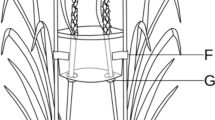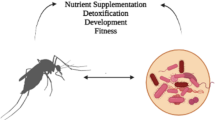Abstract
Adult oviposition preferences are expected to correlate with host plant suitability for the development of their offspring. For most lepidopteran species, this is particularly important as the hatching neonate larvae of many species are relatively immobile. Thus, the site of oviposition chosen by a female adult can greatly influence the probability of survival for her offspring. In the present study, we investigated the oviposition preference of adult Trichoplusia ni moths for six plant species to determine whether they could accurately rank the suitability of the plants for larval development. We also compared oviposition preferences to neonate larval acceptance and preference to determine whether the adult host range matched that of larval diet breath. Our results indicate that in two-choice and no-choice tests adult T. ni were able to rank the plants accurately, with the exception of anise hyssop. However, when given a choice of all six plants together, they laid more eggs on a plant that was not suitable for larval survival. Larvae accepted and fed on all plants in no-choice tests, and accurately ranked them according to larval performance. We conclude that neonate larvae are better able than adults to rank plants according to larval performance, and that larval diet breadth is wider than the range of plants accepted by adults. We also provide a discussion of the reduced accuracy of adult oviposition preference with increased plant choices.

Similar content being viewed by others
References
Akhtar Y, Isman MB (2003) Larval exposure to oviposition deterrents alters subsequent oviposition behavior in generalist, Trichoplusia ni and specialist, Plutella xylostella moths. J Chem Ecol 29:1853–1870
Akhtar Y, Isman MB (2004) Comparative growth inhibitory and antifeedant effects of plant extracts and pure allelochemicals on four phytophagous insect species. J Appl Entomol 128:32–38
Auerbach M, Simberloff D (1989) Oviposition site preference and larval mortality in a leaf-mining moth. Ecol Entomol 14:131–140
Awmack CS, Leather SR (2002) Host plant quality and fecundity in herbivorous insects. Annu Rev Entomol 47:817–844
Ballabeni P, Rahier M (2000) Performance of leaf beetle larvae on sympatric host and non-host plants. Entomol Exp Appl 97:175–181
Berdegue M, Reitz SR, Trumble JT (1998) Host plant selection and development in Spodoptera exigua: do mother and offspring know best? Entomol Exp Appl 89:57–64
Bernays EA (1998) The value of being a resource specialist: behavioral support for a neural hypothesis. Amer Nat 151:451–464
Bernays EA (1999) When host choice is a problem for a generalist herbivore: experiments with the whitefly, Bemisia tabaci. Ecol Entomol 24:260–267
Bernays EA, Wcislo WT (1994) Sensory capabilities, information-processing, and resource specialization. Quart Rev Biol 69:187–204
Bopp S, Gottsberger G (2004) Importance of Silene latifolia ssp alba and S-dioica (Caryophyllaceae) as host plants of the parasitic pollinator Hadena bicruris (Lepidoptera, Noctuidae). Oikos 105:221–228
Chow JK, Akhtar Y, Isman MB (2005) The effects of larval experience with a complex plant latex on subsequent feeding and oviposition by the cabbage looper moth: Trichoplusia ni (Lepidoptera: Noctuidae). Chemoecology 15:129–133
Courtney SP (1981) Coevolution of pierid butterflies and their cruciferous foodplants: III. Anthocharis cardamines (L). survival, development and oviposition on different host plants. Oecologia 51:91–96
Cranshaw W (2004) Garden insects of North America: the ultimate guide to backyard bugs. Princeton University Press, Princeton, NJ
Damman H, Feeny P (1988) Mechanisms and consequences of selective oviposition by the zebra swallowtail butterfly. Anim Behav 36:563–573
Dempster JP (1969) Some effects of weed control on the numbers of the small cabbage white (Pieris rapae L.) on Brussels sprouts. J Appl Ecol 6:339–345
Dethier VG (1954) Evolution of feeding preferences in phytophagous insects. Evolution 8:33–54
Digweed SC (2006) Oviposition preference and larval performance in the exotic birch-leafmining sawfly Profenusa thomsoni. Entomol Exp Appl 120:41–49
Eben A, Lopez-Carretero A (2008) Asymmetry of larval diet breadth and oviposition preference in Leptinotarsa undecimlineata. In: 13th international symposium on insect-plant interactions. Blackwell Publishing, Uppsala, pp 27–33
Finch S, Collier RH (2000) Host-plant selection by insects—a theory based on ‘appropriate/inappropriate landings’ by pest insects of cruciferous plants. Entomol Exp Appl 96:91–102
Finch S, Edmonds GH (1994) Undersowing cabbage crops with clover—the effects on pest insects, ground beetles and crop yield. IOBC/WPRS Bulletin 17:159–167
Fox LR, Eisenbach J (1992) Contrary choices: possible exploitation of enemy-free space by herbivorous insects in cultivated vs. wild crucifers. Oecologia 89:574–579
Gratton C, Welter SC (1998) Oviposition preference and larval performance of Liriomyza helianthi (Diptera : Agromyzidae) on normal and novel host plants. Environ Entomol 27:926–935
Harris MO, Miller JR (1983) Color stimuli and oviposition behavior of the onion fly, Delia antiqua (Meigen). Ann Entomol Soc Amer 76:766–771
Harris MO, Miller JR (1984) Foliar form influences ovipositional behavior of the onion fly. Physiol Entomol 9:145–155
Harris MO, Miller JR (1988) Host-acceptance behavior in an herbivorous fly, Delia antiqua. J Insect Physiol 34:179–190
Harris MO, Rose S (1990) Chemical, color, and tactile cues influencing oviposition behavior of the Hessian fly (Diptera: Cecidomyiidae). Environ Entomol 19:303–308
Heisswolf A, Obermaier E, Poethke HJ (2005) Selection of large host plants for oviposition by a monophagous leaf beetle: nutritional quality or enemy-free space? Ecol Entomol 30:299–306
Hirota T, Kato Y (2001) Influence of visual stimuli on host location in the butterfly, Eurema hecabe. Entomol Exp Appl 101:199–206
Holland JN, Buchanan AL, Loubeau R (2004) Oviposition choice and larval survival of an obligately pollinating granivorous moth. Evol Ecol Res 6:607–618
Jaenike J (1978) On optimal oviposition behaviour in phytophagous insects. Theor Pop Biol 14:350–356
Jallow MF, Zalucki MP (2003) Relationship between oviposition preference and offspring performance in Australian Helicoverpa armigera (Hubner) (Lepidoptera: Noctuidae). Aust J Entomol 42:343–348
Janz N, Nylin S (1997) The role of female search behaviour in determining host plant range in plant feeding insects: a test of the information processing hypothesis. Proc R Soc London B 264:701–707
Kostal V, Finch S (1994) Influence of background on host plant selection and subsequent oviposition by the cabbage root fly (Delia radicum). Entomol Exp Appl 70:153–163
Landolt PJ (1989) Attraction of the cabbage looper to host plants and host plant odor in the laboratory. Entomol Exp Appl 53:117–124
Leatemia JA, Isman MB (2004) Toxicity and antifeedant activity of crude seed extracts of Annona squamosa (Annonaceae) against lepidopteran pests and natural enemies. Int J Trop Insect Sci 24:150–158
Legg DE, Schenk TC, Chang HC (1986) European corn borer (Lepidoptera: Pyralidae) oviposition preference and survival on sunflower and corn. Environ Entomol 15:631–634
Leite GLD, Picanco M, Guedes RNC, Zanuncio JC (2001) Role of plant age in the resistance of Lycopersicon hirsutum f. glabratum to the tomato leafminer Tuta absoluta (Lepidoptera: Gelechiidae). Sci Hortic 89:103–113
Levins R, MacArthur RH (1969) A hypotheses to explain the incidence of monophagy. Ecology 50:910–911
Liu SS, Liu TX (2006) Preimaginal conditioning does not affect oviposition preference in the diamondback moth. Ecol Entomol 31:307–315
Mayhew PJ (1997) Adaptive patterns of host-plant selection by phytophagous insects. Oikos 79:417–428
Miller JR, Strickler KL (1984) Finding and accepting host plants. In: Bell W, Carde R (eds) Chemical ecology of insects. Chapman & Hall, London, pp 127–155
Nylin S, Janz N (1993) Oviposition preference and larval performance in Polygonia C-Album (Lepidoptera, Nymphalidae)—the choice between bad and worse. Ecol Entomol 18:394–398
Nylin S, Bergstrom A, Janz N (2000) Butterfly host plant choice in the face of possible confusion. J Insect Behav 13:469–482
Pelletier Y, Grondin G, Maltais P (1999) Mechanism of resistance to the Colorado potato beetle in wild Solanum species. J Econ Entomol 92:708–713
Perrin RM, Phillips ML (1978) Some effects of mixed cropping on the population dynamics of insect pests. Entomol Exp Appl 24:385–393
Poykko H (2006) Females and larvae of a geometrid moth, Cleorodes lichenaria, prefer a lichen host that assures shortest larval period. Environ Entomol 35:1669–1676
Rajapakse CNK, Walter GH (2007) Polyphagy and primary host plants: oviposition preference versus larval performance in the lepidopteran pest Helicoverpa armigera. Arthropod-Plant Interact 1:17–26
Rausher MD (1982) Population differentiation in Euphydryas editha butterflies: larval adaptation to different hosts. Evolution 36:581–590
Rausher MD, Papaj DR (1983) Demographic consequences of discrimination among conspecific host plants by Battus philenor butterflies. Ecology 64:1402–1410
Renwick JAA (2001) Variable diets and changing taste in plant-insect relationships. J Chem Ecol 27:1063–1076
Resetarits WJ (1993) Oviposition site choice and life history evolution. In: Symposium on maternal effects on early life history, their persistence, and impact on organismal ecology, at the annual meeting of the american-society-of-zoologists. Amer Soc Zoologists, Los Angeles, CA, pp 205–215
Rostas M, Hilker M (2002) Feeding damage by larvae of the mustard leaf beetle deters conspecific females from oviposition and feeding. Entomol Exp Appl 103:267–277
Ryan J, Ryan MF, McNaeidhe F (1980) The effect of interrow plant cover on populations of cabbage rootfly. Delia brassicae (Wied.). J Appl Ecol 17:31–40
Schoni R, Stadler E, Renwick JAA, Radke CD (1987) Host and non-host plant chemicals influencing the oviposition behavior of several herbivorous insects. In: Labeyrie V, Fabres G, Lachaise D (eds) Insects–plants. W. Junk, Dordrecht, pp 31–36
Shikano I, Isman MB (2009) A sensitive period for larval gustatory learning influences subsequent oviposition choice by the cabbage looper moth. Anim Behav 77:247–251
Singer MC (1984) Butterfly-host plant relationships: host quality, adult choice and larval success. In: Vane-Wright R, Ackery PR (eds) The biology of butterflies. Academic Press, New York, pp 81–88
Singer MC (1986) The definition and measurement of oviposition preference in plant feeding insects. In: Miller JR, Miller TR (eds) Insect–plant interactions. Springer, New York, pp 65–94
Singer MC, Thomas CD, Billington HL, Parmesan C (1994) Correlates of speed of evolution of host preference in a set of twelve populations of the butterfly Euphydryas editha. Ecoscience 1:107–114
Smith JG (1976) Influence of crop backgrounds on aphids and other phytophagous insects on Brussels sprouts. Ann Appl Biol 83:1–13
Tahvanainen JO, Root RB (1972) The influence of vegetational diversity on the population ecology of a specialized herbivore, Phyllotreta crucifera (Coleoptera: Chrysomelidae). Oecologia 10:321–346
Theunissen J, den Ouden H (1980) Effects of intercropping with Spergula arvensis on pests of Brussels sprouts. Entomol Exp Appl 27:260–268
Thompson JN (1983) The use of ephemeral plant parts on small host plants: how Depressaria leptotaeniae (Lepidoptera: Oecophoridae) feeds on Lomatium dissectum (Umbelliferae). J Anim Ecol 52:281–291
Thompson JN (1988) Evolutionary ecology of the relationship between oviposition preference and performance of offspring in phytophagous insects. Entomol Exp Appl 47:3–14
Wiklund C (1975) The evolutionary relationship between adult oviposition preferences and larval host plant range in Papilio machaon L. Oecologia 18:185–197
Acknowledgments
This project was supported by a Discovery grant from the Natural Sciences and Engineering Research Council of Canada (NSERC) to MBI and an NSERC Post Graduate Scholarship-Masters (NSERC PGS-M) to IS.
Author information
Authors and Affiliations
Corresponding author
Additional information
Handling Editors: Gimme Walter and Heikki Hokkanen.
Rights and permissions
About this article
Cite this article
Shikano, I., Akhtar, Y. & Isman, M.B. Relationship between adult and larval host plant selection and larval performance in the generalist moth, Trichoplusia ni . Arthropod-Plant Interactions 4, 197–205 (2010). https://doi.org/10.1007/s11829-010-9100-9
Received:
Accepted:
Published:
Issue Date:
DOI: https://doi.org/10.1007/s11829-010-9100-9




